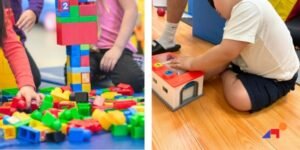Understanding the Sibling Experience: “I Have Needs Too”
Before diving into strategies, it’s crucial to understand what siblings of children in therapy actually experience. Recent comprehensive research involving 31 studies has identified four fundamental emotional truths that siblings consistently express: “I am not the only one,” “I have needs too,” “I need my parents’ attention,” and “I need a break.” These aren’t just passing feelings—they represent genuine psychological needs that, when unaddressed, can lead to behavioral problems, academic difficulties, and long-term relationship challenges.
A 2021 study published in the National Institutes of Health (NIH) Public Access highlights that siblings of children with rare disorders experience more psychosocial challenges, emphasizing the need for family-centered interventions in pediatric therapy.
Siblings often misunderstand therapy sessions, sometimes believing their brother or sister is being hurt when they hear crying or see challenging exercises. Eight-year-old Emma initially thought Marcus was being punished during his sessions because he sometimes became frustrated with motor skills activities. This misunderstanding created anxiety and protective feelings that manifested as disruptive behavior during therapy visits and resentment toward the therapeutic process.
The attention imbalance is another significant challenge. Therapy sessions, home exercise programs, and behavioral interventions naturally require focused parental attention, often leaving siblings feeling overlooked or less important. Research shows that siblings report more positive experiences when parents make deliberate efforts to acknowledge this reality and take specific steps to address it.
Emotional isolation can develop when siblings feel they cannot express negative feelings about their sibling’s condition or therapy needs. Children may believe they’re being “bad” for feeling jealous or frustrated, leading them to suppress legitimate emotional responses. Vancouver families who create safe spaces for these conversations report stronger overall family cohesion and fewer behavioral issues in typically developing siblings.
Understanding these experiences helps parents recognize that sibling reactions aren’t character flaws or temporary phases—they’re normal responses to significant family changes that require thoughtful, proactive support strategies.
Creating Inclusive Communication: Age-Appropriate Therapy Education

One of the most powerful tools for supporting sibling relationships is open, age-appropriate communication about therapy. Children who understand why their sibling needs therapy and how it helps are significantly more likely to become supportive family members rather than resentful competitors for parental attention.
For preschool siblings (ages 3-5), focus on simple, concrete explanations: “Marcus’s muscles need extra practice to get stronger, just like how you practice riding your bike to get better.” Use visual aids, toys, or demonstration games to help young children understand therapeutic concepts. Many Vancouver families create “therapy story books” using photos of their child’s actual sessions, helping siblings understand what happens during appointments.
Elementary-age siblings (ages 6-10) can handle more detailed explanations about specific therapeutic goals. “Emma, you remember learning to tie your shoes was hard at first? Marcus’s brain needs extra help learning how his hands and eyes work together for writing and drawing.” Include siblings in celebrating therapy milestones—when Marcus successfully completed a challenging fine motor task, Emma helped create a “achievement certificate” at home.
Pre-teen and teenage siblings can participate in family therapy discussions and even attend occasional sessions when appropriate. These older siblings often become valuable therapy partners when they understand the science behind interventions. Some Vancouver teens have reported feeling proud and mature when asked to help with home exercise programs or behavioral consistency strategies.
Regular family meetings about therapy progress, challenges, and goals help siblings feel included rather than excluded from this significant family focus. Keep these conversations positive and solution-focused, emphasizing how therapy helps their sibling reach their potential rather than focusing on deficits or problems.
Strategic Sibling Involvement: Making Therapy a Team Effort
Research consistently shows that actively involving siblings in the therapy process yields considerable benefits for both the child receiving treatment and overall family atmosphere. However, this involvement must be carefully structured to ensure siblings feel empowered rather than burdened with caregiving responsibilities.
Therapy session participation can be incredibly valuable when managed appropriately. At KidStart Pediatric Therapy, we often invite siblings to observe or participate in specific activities that showcase their brother or sister’s progress. Emma loved helping Marcus practice cutting activities, transforming a challenging fine motor skill into a collaborative art project. This involvement helped Emma understand why her brother needed extra practice while giving her a special role in his success.
Home program partners become natural when siblings understand therapeutic goals. Instead of viewing home exercises as “Marcus’s boring therapy work,” Emma began seeing their daily gross motor activities as fun sister-brother challenges. They created obstacle courses together, with Emma providing encouragement and celebrating Marcus’s improvements. This shift transformed therapy exercises from family disruptions into bonding activities.
Peer modeling opportunities are particularly powerful. Siblings naturally demonstrate age-appropriate behaviors and social skills, providing authentic learning opportunities that therapists cannot replicate. When Marcus struggled with turn-taking during board games, Emma’s patient modeling and gentle coaching proved more effective than formal therapeutic interventions.
Special sibling roles help children feel valued and important in their sibling’s therapeutic journey. Some Vancouver families designate siblings as “progress photographers,” documenting achievements and creating therapy scrapbooks. Others assign siblings as “home exercise equipment managers,” giving them ownership over therapy materials and activities. These roles create positive investment in therapeutic outcomes while building sibling pride and connection.
Protecting Individual Needs: Dedicated Time and Attention
While inclusive strategies are important, dedicated one-on-one time with typically developing siblings remains essential for maintaining healthy family dynamics. Research demonstrates that siblings report more positive experiences when parents make deliberate efforts to provide individual attention, acknowledging that therapy shouldn’t monopolize family focus.
Scheduled individual time doesn’t need to be elaborate or time-consuming, but it must be consistent and protected. Sarah established “Emma time” every Tuesday and Thursday while Marcus had therapy sessions—thirty minutes dedicated entirely to Emma’s interests, questions, and activities. This consistency helped Emma understand that her needs were equally important, even when they required different types of support.
Interest-based activities during individual time should focus entirely on the sibling’s preferences and developmental needs. Emma loved art projects, so her dedicated time often involved painting, drawing, or craft activities that had nothing to do with therapy or Marcus’s needs. This separation was crucial for Emma’s sense of individual identity and worth within the family.
Take advantage of BC Children’s Sauder Sibling Centre and similar Vancouver resources that provide safe, structured support for siblings during medical or therapeutic appointments. These programs offer age-appropriate activities, peer connections, and trained staff who understand sibling experiences. Many families report that these programs help siblings feel special and supported rather than burdened by their sibling’s therapeutic needs.
Extended family and friend support can provide additional individual attention and respite. Grandparents, aunts, uncles, or close family friends can offer siblings special outings or activities that provide emotional support and individual focus. These relationships become particularly valuable during intensive therapy periods when parental attention is necessarily divided.
Building Long-Term Resilience: Teaching Advocacy and Empathy
The ultimate goal of supporting sibling relationships during therapy isn’t just managing immediate challenges—it’s building lifelong skills in empathy, advocacy, and resilience that will benefit all family members throughout their lives. Vancouver families who approach therapy as an opportunity for character development often discover that siblings develop remarkable emotional intelligence and compassion.
Teaching advocacy skills helps siblings become powerful allies rather than competitors. Emma learned to speak up for Marcus when other children didn’t understand his needs, but also learned appropriate boundaries about when advocacy was her responsibility versus when adults should intervene. This balance helped her develop leadership skills while maintaining healthy sibling dynamics.
Empathy development occurs naturally when siblings understand differences without being overwhelmed by caregiving responsibilities. Children who participate appropriately in their sibling’s therapy journey often develop enhanced ability to understand and connect with diverse peers throughout their lives. Many Vancouver teachers report that siblings of children receiving therapy demonstrate exceptional kindness and inclusion skills in classroom settings.
Resilience building happens when families frame therapy challenges as opportunities for growth rather than burdens to endure. Siblings learn that everyone has different strengths and challenges, that seeking help is a sign of strength, and that families support each other through difficulties. These lessons serve children well when they face their own challenges later in life.
Future relationship benefits extend well beyond childhood. Research indicates that siblings who receive appropriate support during one child’s therapy often maintain closer, more understanding relationships as adults. They develop skills in communication, compromise, and mutual support that strengthen family bonds throughout their lives.
Community connection often emerges when families embrace their therapy journey openly. Many Vancouver families discover supportive communities of other families with similar experiences, creating lasting friendships and support networks. Siblings benefit from meeting other children who understand their experiences, reducing isolation and building peer connections.
Practical Warning Signs and When to Seek Additional Support
While some adjustment challenges are normal when a child begins therapy, certain warning signs indicate siblings may need additional professional support. Early intervention for sibling emotional needs can prevent long-term relationship damage and ensure the entire family benefits from the therapeutic process.
Behavioral regression in typically developing siblings—such as sleep disruptions, toileting accidents, or loss of previously mastered skills—may indicate overwhelming stress or emotional needs. Emma temporarily returned to bedtime fears she had outgrown, signaling that she needed additional emotional support and reassurance about her place in the family.
Academic or social difficulties that coincide with a sibling’s therapy start may reflect emotional distraction or unmet needs. When children worry about their sibling or feel guilty about their own abilities, concentration and peer relationships often suffer. Vancouver school counselors report increased success when parents communicate about family therapy situations and work collaboratively to support all children.
Persistent negative emotions about their sibling’s therapy—lasting anger, sadness, or anxiety that doesn’t improve with typical support strategies—may require professional intervention. Child psychologists specializing in sibling dynamics can provide valuable assessment and support when family strategies alone aren’t sufficient.
Physical symptoms without medical causes, such as frequent headaches, stomach aches, or unexplained fatigue, sometimes reflect emotional stress related to family changes. These symptoms warrant both medical evaluation and consideration of emotional support needs.
KidStart Pediatric Therapy offers family consultation services that address sibling concerns as part of comprehensive treatment planning. Our team recognizes that successful therapy outcomes depend on healthy family dynamics and can provide guidance, resources, and referrals when siblings need additional support beyond typical family management strategies.
FAQs
How can pediatric therapists support siblings during therapy sessions?
Pediatric therapists often incorporate sibling involvement by educating siblings about therapy goals and including them in simple activities, which helps reduce feelings of exclusion and promotes family cohesion.What are common emotional challenges siblings face that pediatric therapists help address?
Siblings may experience jealousy, confusion, or anxiety about therapy; pediatric therapists provide family counseling and resources to help siblings express their feelings and foster understanding.How does KidStart Pediatric Therapy customize support for sibling relationships?
KidStart Pediatric Therapy offers family consultations and specialized programs to guide parents in managing sibling dynamics and ensuring all children’s emotional needs are met during therapy.Can sibling involvement improve therapy outcomes for children receiving pediatric behavioral therapy?
Yes, active sibling participation often enhances motivation and progress by creating a supportive environment and reinforcing therapeutic skills outside of sessions.How does pediatric therapy at KidStart address the family as a whole?
KidStart Pediatric Therapy focuses not only on the child in therapy but also provides tools and guidance to strengthen family bonds and improve communication among siblings and parents.
People Also Ask
What strategies can parents use to help siblings cope with therapy-related changes?
Parents can maintain open communication, schedule individual time with siblings, and encourage sibling involvement in therapy-related activities to support emotional adjustment.How do pediatric therapists recommend handling sibling jealousy during therapy?
Therapists suggest acknowledging siblings’ feelings, validating their experiences, and reinforcing their unique strengths and contributions to the family.Are there community resources to help siblings of children in therapy?
Yes, centers like BC Children’s Sauder Sibling Centre provide peer support, educational activities, and counseling tailored to siblings’ needs.Why is age-appropriate therapy education important for siblings?
Understanding therapy in relatable terms reduces fear and misunderstandings, promoting empathy and cooperation among siblings.How can siblings positively influence a child’s therapy progress?
By modeling social behaviors, providing encouragement, and participating in home exercises, siblings contribute meaningfully to therapeutic success.






